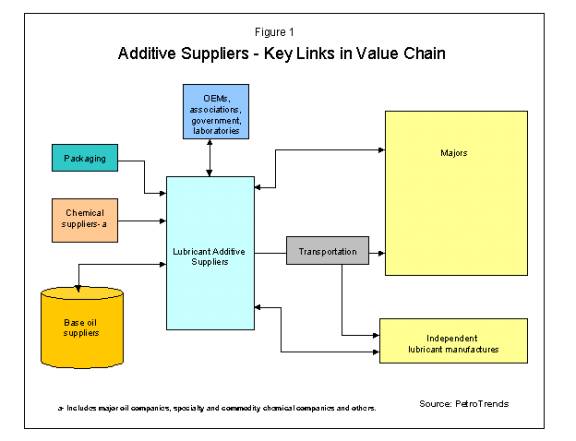|
The True Value of the Lubricant
Additives Business
Compoundings Magazine, March
2002
By Thomas F. Glenn
Petroleum Trends International, Inc.
The lubricant additives business is big, complex,
and a key part of the lubricants industry. In addition, it’s
a changing business and one that adds significantly more than chemical
packages and components to the value chain. It is also a business
well positioned to add even greater value in the future. Understanding
this value and how it might evolve starts with a look at the position
additive suppliers have in the value chain.
Links in the Chain…
Lubricant additive suppliers are
an integral part of the lubricants value chain. They connect with
seven major links in the chain, as shown in Figure 1, and play a
key role in defining and refining the functionality of finished
lubricants.
On the buy side of the chain, additive
manufacturers purchase base oils to solubilize additives, and dilute
them into manageable concentration. Collectively, consumption of
base oil by additive manufactuers in the US reached close to 130
million gallons in 2001 and includes both paraffinic and napthenic.
In addition to purchasing base oils, additive manufacturers also
work collaboratively with base oil manufacturers to optimize performance
in new stocks.
Another link on the buy side of
the value chain for additive manufacturers are suppliers basic in
such intermediate chemicals as amines, dodecyl phenol, olefin copolymer,
methacrylate, styrene-isoprene, and other raw materials used to
manufacture lubricant additives. Although some lubricant additive
manufactures are basic in these and other chemistries, the diversity
of materials required tomanufacture additives necessitates the need
for most to purchase some raw materials from other suppliers. In
addition to adding value to these materials by milling, reacting,
compounding, and packaging for use as lubricant additives, additive
manufacturers also add value by leveraging buying power, assuring
consistent quality, and by working with raw material suppliers to
enhance performance.

Packaging manufactures represent another buy side link in the value
chain. Although a significant quality of additive is shipped in
bulk, additives are also sold in 55-gal drums and other containers.
The additive manufacture’s link to packaging material suppliers
can also go beyond buying. It sometimes includes interactions regarding
issues related to the compatibility of finished lubricants with
packaging materials, appearance, and other considerations.
Another critical link in the value
chain is the highly interactive one additive manufactures have with
original equipment manufacturers (OEMs), trade associations, engine
test laboratories, government agencies and others involved in influencing,
implementing and assessing the performance of lubricants. Additive
suppliers work collaboratively with these stakeholders to develop
specifications and test protocols, assure compliance, establish
timetables, provide information, and to address health and safety
and other product and application related issues.
The sell side of the value chain
for lubricant additive manufactures includes primarily major oil
companies and independent lubricant manufacturers. Taken together,
additive packages and components purchases by majors and independent
in the US reached and estimated 2 billion pounds value at almost
$1.6 billion in 2001. These numbers alone, however, do not speak
to the true value of the business or its potential moving forward.
The true value of the business…
Rather than competing simply as
suppliers of chemicals, lubricant additive manufactures have evolved
into a role where they are highly competent, collaborative, and
proactive partners with virtually all stakeholders in lubricant
value chain. They are expected to work with these stakeholders to
develop and meet the continuously changing performance requirements
of all finished lubricants. They are also expected to work with
customers to develop proprietary formulations, address blending
issues, build on market intelligence, position products, solve problems,
and handle technical and customer service related issues. As a result,
expertise and technology in both product development and additive
manufacturing have become the core competency of most lubricant
additive manufactures. And for most, these competencies are a requirement
of being in the additives business, not an option. This reality,
together with the bandwidth additive suppliers have in the value
chain, electronic interconnectivity of lubricant industry stake
holders, redundancies in the value chain, the industry life cycle,
intensity of competition, and others suggest that additive suppliers
are well positioned to contribute even more to the lubricant value
chain in the future… This will be the subject of the next
Top Line column.
Copyright © Petroleum Trends International,
Inc. 2002
|
